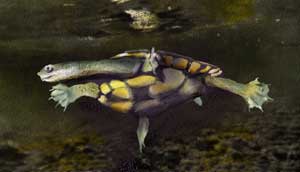|
|
|
|
|
|
species spotlight
on

Chelodina longicollis
A.K.A. The snake-necked turtle, the long necked turtle, the stinker, the smooth snake neck turtle.
As it's name implies, the neck of Chelodina longicollis is disproportionately long. When extended, the neck is longer than half the length of it's shell. Other distinguishing features of this turtle are webbed toes, claws, and warty skin which is a gray color. The shell is brown to black and will reach 10 - 11 inches in length. This animal will grow to weigh 2.5 pounds and has a life expectancy of 17 - 50 years.
Most snake-necked turtles live close by streams, rivers, swamps, and lagoons of eastern Australia. From time to time, they migrate over land in groups to search out new habitats. It is not unusual for these turtles to colonize man made ponds.
Chelodina longicollis hunts and feeds on other aquatic creatures. Among it's dietary choices are: insects, amphibians, fish, and many different types of water dwelling invertebrates. The turtle's long neck is an advantageous hunting tool.
A formidable weapon of this turtle is a foul smelling fluid which it can spray up to three feet in the direction of an enemy. This malodorous liquid works well as a defense employed by the adult turtles. Unhappily, many Chelodina longicollis do not live long enough to reach adulthood. Eggs are eaten by water rats and monitor lizards. Young hatchlings often become meals for fish and birds. Even in adulthood, life can be rough. Many of these turtles are killed by fishermen and vehicles. They also suffer due to the loss of their aquatic abodes.
Water habitats are crucial to this turtle. Courtship and mating take place underwater during September and October. In November or December, the female will lay and bury her eggs in terrain near the water. Six to twenty-four eggs are usually present in a clutch. Six months after the eggs are laid, the turtles will hatch and scurry toward the water.
For more info, see the following web pages:
http://www.tortoise.org/archives/chelodin.html
http://www.lexicon.net/adder/chelon1.htm
http://aerg.canberra.edu.au/pub/aerg/herps/ash96tur.htm